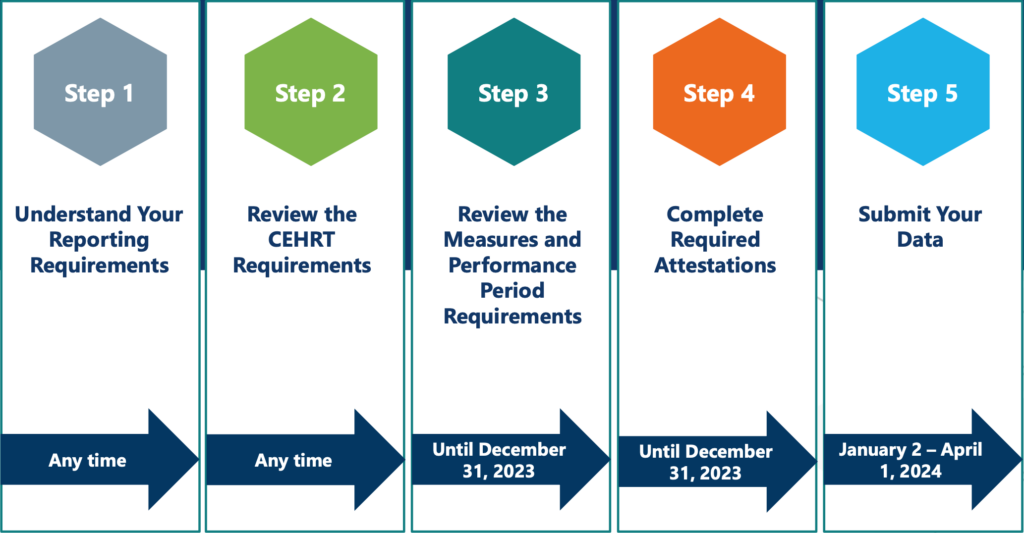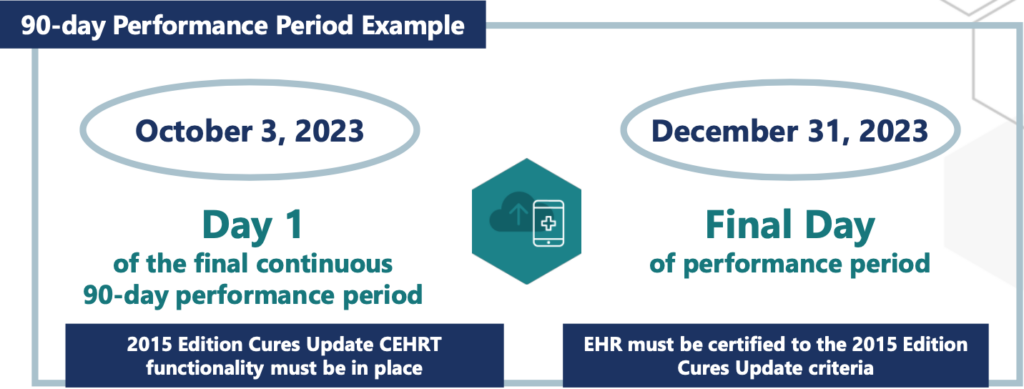The Promoting Interoperability category of MIPS focuses on using certified electronic health records (CEHRT) to improve patient access to their health data, enhance information exchange between clinicians and pharmacies, and boost systematic healthcare data collection and analysis. This category could account for 25% – 85% of your 2023 MIPS Final Score, based on your reporting strategy. For PY 2023, there are 5 steps for submitting in the Promoting Interoperability Category:

Step 1: Understand Your Reporting Requirements:
Some MIPS eligible clinicians and groups are not required to submit data for this performance category if they qualify for automatic reweighting to 0%. This means that the performance category’s 25% weight is redistributed to other performance categories. Clinicians who qualify for automatic reweighting may still submit data, however, doing so will cancel the reweighting, and CMS will score your performance and weight your Promoting Interoperability performance category at 25% of your MIPS final score.
The graphic below shows the different clinician types and special statuses that qualify for automatic reweighting of the Promoting Interoperability performance category

If you do not qualify for automatic reweighting but are unable to submit data for the Promoting Interoperability performance category, you may submit a MIPS Promoting Interoperability Performance Category Hardship Exception application. This application is available to MIPS eligible clinicians, groups, and virtual groups whether they are reporting traditional MIPS, MVPs, or the APP. If the Hardship Exception application is approved by CMS, the Promoting Interoperability performance category will be reweighted to 0%. Be aware that submitting any data will override an approved Hardship Exception and the category will be scored.
The deadline to apply for the 2023 MIP Promoting Interoperability Performance Category Hardship Exception is January 2, 2024.
Step 2: Review the CEHRT Requirements
To meet the CEHRT requirements for 2023 Promoting Interoperability performance category, you’ll need to:
- Have 2015 Edition Cures Update CEHRT functionality in place by the first day of your Promoting Interoperability performance period;
- Have your EHR certified by ONC to the 2015 Edition Cures Update CEHRT criteria by the last day of your performance period; and
- Provide your EHR’s CMS identification code from the Certified Health IT Product List (CHPL), available on HealthIT.gov, when you submit your data.
Work with your EHR vendor to verify that your system is on track to meet CEHRT requirements by the last day of your performance period.

Step 3: Review the Measures and Performance Period Requirements
The 2023 Promoting Interoperability performance category focuses on the following objectives:
- e-Prescribing
- Health Information Exchange
- Provider to Patient Exchange
- Public Health and Clinical Data Exchange
Within the objectives, there are 6 to 7 mandatory measures that must be reported, along with required attestations. Some measures have exclusions that you can claim if you qualify. You must gather data for all necessary measures (unless you can claim an applicable exclusion) for a minimum of any continuous 90-day period in 2023. The last 90-day performance period starts on October 3, 2023.
Step 4: Complete Required Attestations
Step 4a: Perform or Review a Security Risk Analysis
You need to conduct or review a Security Risk Analysis (SRA) on your 2015 Edition Cures Update CEHRT on a yearly basis. This can be done anytime in 2023, but it must be completed by December 31st, 2023.
Step 4b: Perform an Annual Assessment of the High Priority Guide (from the SAFER Guides)
You must conduct a self-assessment using the High Priority Practices Guide annually, within the calendar year of the performance period. This can be done anytime in 2023, but it must be completed by December 31st, 2023. More guidance can be found on the SAFER Guides page on HealthIT.gov.
Step 4c: Complete the Actions to Limit or Restrict Interoperability of CEHRT Attestation
This attestation asks if you or your health IT vendor knowingly and willfully limited or restricted the compatibility or interoperability of your CEHRT.
To complete the attestation, enter a “yes” (you didn’t knowingly or willfully take action to limit or restrict compatibility or interoperability of CEHRT) or “no” (you did knowingly or willfully take action to limit or restrict compatibility or interoperability of CEHRT) response. Submitting a “no” response will result in a score of 0 for the entire performance category.
Step 4d: ONC Direct Review attestation
This attestation statement aims to identify whether you acted in good faith and would cooperate if the ONC initiates a direct review of your health IT.
To complete the attestation, enter a “yes” (agree to cooperate in a direct review of your health IT in the event that you receive a review request from the ONC) or “no” (you don’t agree to cooperate in a direct review) response. Submitting a “no” response will result in a score of 0 for the entire performance category.
Step 5: Submit Your Data
You will need to report the required Promoting Interoperability performance category data during the 2023 submission period (1/2/2024 – 4/1/2024). You don’t need to include supporting documentation when you attest, but you must keep documentation for at least 6 years subsequent to submission.
To learn more about Promoting Interoperability, check out our latest deep dive webinar on the topic here.
